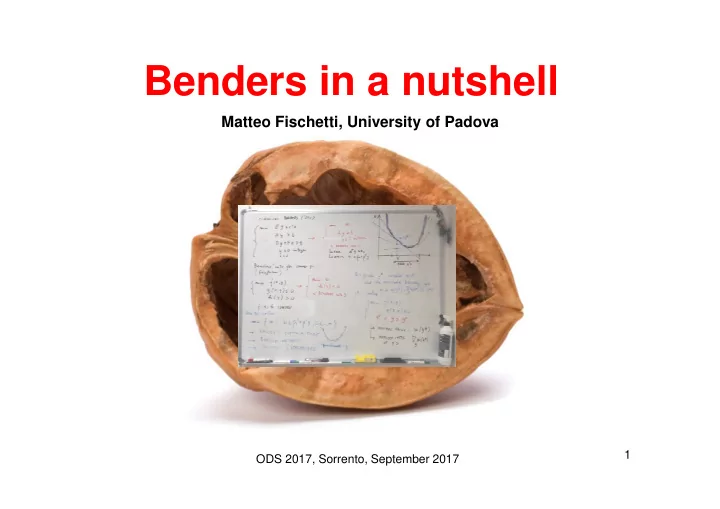

Benders in a nutshell Matteo Fischetti, University of Padova 1 ODS 2017, Sorrento, September 2017
Benders decomposition • The original Benders decomposition from the 1960s uses two distinct ingredients for solving a Mixed-Integer Linear Program (MILP): 1) A search strategy where a relaxed (NP-hard) MILP on a variable subspace is solved exactly (i.e., to integrality ) by a black-box solver, and then is iteratively tightened by means of additional “Benders” linear cuts 2) The technicality of how to actually compute those cuts (Farkas’ projection) – Papers proposing “a new Benders-like scheme” typically refer to 1) – Students scared by “Benders implementations” typically refer to 2) Later developments in the 1970s: – Folklore (Miliotios for TSP?): generate Benders cuts within a single B&B tree to cut any infeasible integer solution that is going to update the incumbent – McDaniel & Devine (1977): use Benders cuts to cut fractional sol.s as well (root node only) • Everything fits very naturally within a modern Branch-and-Cut (B&C) framework. ODS 2017, Sorrento, September 2017 2
Branch-and-Cut (B&C) • B&C was proposed by Padberg and Rinaldi in the 1990s and is nowadays the method of choice for solving MIPs • B&C is a clever mixture of cutting-plane and branch-and-bound methods • Since the beginning, an highly-effective implementation was part of the B&C trademark (use of cut pool, global vs local cuts, variable pricing, etc.) pricing, etc.) • Modern commercial B&C solvers such as IBM ILOG Cplex, Gurobi, XPRESS etc. can be fully customized by using callback functions • Callback functions are just entry points in the B&C code where an advanced user (you!) can add his/her customized cuts , heuristics, etc. ODS 2017, Sorrento, September 2017 3
Benders cuts • Consider the convex MINLP in the (x,y) space and let that the convex function is well defined for every y in � no “ Benders feasibility cut ” needed (otherwise, see the full paper) ODS 2017, Sorrento, September 2017 4
Working on the y-space (projection) (1) (2) (3) “isolate the inner minimization over x” Original MINLP in the (x,y) space � Benders’ master problem in the y space Warning : projection changes the objective function (e.g., linear � convex nonlinear) 5 ODS 2017, Sorrento, September 2017
Outer-approximation of the Φ function • Solving Benders’ master problem calls for the minimization of a nonlinear convex function (even if you start from a linear problem!) • Branch-and-cut MINLP solvers generate a sequence of linear cuts to approximate this sequence of linear cuts to approximate this function from below ( outer-approximation ) subgradient (aka Benders) cut at a given y* � Taylor’s first order approx. ODS 2017, Sorrento, September 2017 6
Benders cut separation • Benders (for linear) and Geoffrion (general convex) showed how to compute a subgradient to be used in the cut derivation, by using the optimal primal-dual solution (x*,u*) available after computing • • We propose the use of the following simpler and completely general We propose the use of the following simpler and completely general recipe to generate a (most violated) Benders cut for a given y* . ODS 2017, Sorrento, September 2017 7
Benders feasibility cuts • For some important applications, the set can be empty for some “ infeasible ” y ∈ S � undefined • This situation can be handled by considering the “phase-1” feasibility condition where the function is convex � it can be approximated by the usual subgradient “Benders feasibility cut” to be computed as in the previous “Benders optimality cut” ODS 2017, Sorrento, September 2017 8
Successful Benders applications • Benders decomposition works well when fixing y = y* for computing makes the problem much simpler to solve . • This usually happens when – The problem for y = y* decomposes into a number of independent subproblems • Stochastic Programming • Stochastic Programming • Uncapacitated Facility Location • etc. – Fixing y = y* changes the nature of some constraints: • in Capacitated Facility Location, tons of constr.s of the form become just variable bounds • Second Order Cone const.s become quadratic • etc. ODS 2017, Sorrento, September 2017 9
Cut-loop stabilization • In practice, Benders decomposition can work quite well, but sometimes it is desperately slow at the root node (the lower bound does not improve even after the addition of tons of Benders cuts) • Slow convergence is generally attributed to the poor quality of Benders cuts, to be cured by a more clever selection policy (Pareto optimality of Magnanti and Wong, 1981, etc.) • An important role is also played by the Kelley’s cut loop (always cut an optimal vertex of the current master problem) � try alternative schemes that cut an internal point of the master relaxation (analytic center, bundle, in-out, etc.) ODS 2017, Sorrento, September 2017 10
Effect of the improved cut loop • Comparing Kelley cut loop at the root node with Kelley+ (add epsilon to y*) and with our chase-the-carrot method ( inout ) • Koerkel-Ghosh qUFL instance gs250a-1 (250x250, quadratic costs) • *nc = n. of Benders cuts generated at the end of the root node • times in logarithmic scale ODS 2017, Sorrento, September 2017 11
Conclusions To summarize: • Benders cuts are easy to implement within modern B&C (just use a callback where you solve the problem for y = y* and compute reduced costs) • Kelley’s cut loop can be desperately slow hence stabilization is a must • Suitable for general MIP solvers (already in Cplex 12.7) Slides available at http://www.dei.unipd.it/~fisch/papers/slides/ Slides available at http://www.dei.unipd.it/~fisch/papers/slides/ Reference papers: . M. Fischetti, I. Ljubic, M. Sinnl, "Benders decomposition without separability: a computational study for capacitated facility location problems", European Journal of Operational Research, 253, 557-569, 2016. M. Fischetti, I. Ljubic, M. Sinnl, "Redesigning Benders Decomposition for Large Scale Facility Location", to appear in Management Science, 2016. ODS 2017, Sorrento, September 2017 12
Recommend
More recommend